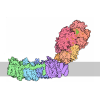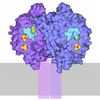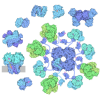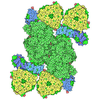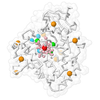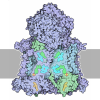+ Open data
Open data
- Basic information
Basic information
| Entry | Database: PDB / ID: 9nez | ||||||
|---|---|---|---|---|---|---|---|
| Title | Structure of the Pyrococcus furiosus SHI complex | ||||||
 Components Components | (Sulfhydrogenase 1 subunit ...) x 4 | ||||||
 Keywords Keywords | ELECTRON TRANSPORT / hydrogen production / [NiFe] hydrogenase / cryo-EM structure | ||||||
| Function / homology |  Function and homology information Function and homology informationsulfhydrogenase / sulfur reductase activity / hydrogen dehydrogenase (NADP+) / hydrogen dehydrogenase (NADP+) activity / [Ni-Fe] hydrogenase complex / pyrimidine nucleotide biosynthetic process / ferredoxin hydrogenase activity / 3 iron, 4 sulfur cluster binding / nickel cation binding / 2 iron, 2 sulfur cluster binding ...sulfhydrogenase / sulfur reductase activity / hydrogen dehydrogenase (NADP+) / hydrogen dehydrogenase (NADP+) activity / [Ni-Fe] hydrogenase complex / pyrimidine nucleotide biosynthetic process / ferredoxin hydrogenase activity / 3 iron, 4 sulfur cluster binding / nickel cation binding / 2 iron, 2 sulfur cluster binding / flavin adenine dinucleotide binding / 4 iron, 4 sulfur cluster binding / metal ion binding / cytoplasm Similarity search - Function | ||||||
| Biological species |   Pyrococcus furiosus (archaea) Pyrococcus furiosus (archaea) | ||||||
| Method | ELECTRON MICROSCOPY / single particle reconstruction / cryo EM / Resolution: 3.47 Å | ||||||
 Authors Authors | Xiao, X. / Li, H. | ||||||
| Funding support |  United States, 1items United States, 1items
| ||||||
 Citation Citation |  Journal: Structure / Year: 2025 Journal: Structure / Year: 2025Title: Structural insights into the biotechnologically relevant reversible NADPH-oxidizing NiFe-hydrogenase from P.furiosus. Authors: Xiansha Xiao / Gerrit J Schut / Xiang Feng / Patrick M McTernan / Dominik K Haja / William N Lanzilotta / Michael W W Adams / Huilin Li /  Abstract: The cytoplasmic hydrogenase I (SHI) from the hyperthermophilic archaeon Pyrococcus furiosus belongs to the group III hydrogenase family. SHI oxidizes NADPH rather than NADH to reduce protons and ...The cytoplasmic hydrogenase I (SHI) from the hyperthermophilic archaeon Pyrococcus furiosus belongs to the group III hydrogenase family. SHI oxidizes NADPH rather than NADH to reduce protons and evolve hydrogen gas, and because of this property, coupled with its high thermal stability, the enzyme holds great potential for economical hydrogen production. Despite decades of efforts, the SHI structure has remained unknown. Here, we report the cryoelectron microscopic (cryo-EM) structures of the heterotetrameric SHI holoenzyme (αδβγ). SHI is a symmetric dimer of two individually functional heterotetramers. SHI-αδ resembles the standard [NiFe] hydrogenase, and SHI-βγ function as the NADPH oxidoreductase. SHI-β contains three [4Fe-4S] clusters that relay electrons from NADPH in SHI-γ to the catalytic [NiFe] cluster in SHI-αδ for H production. These structures will guide the adaptation of this unique enzyme for biotechnological applications. | ||||||
| History |
|
- Structure visualization
Structure visualization
| Structure viewer | Molecule:  Molmil Molmil Jmol/JSmol Jmol/JSmol |
|---|
- Downloads & links
Downloads & links
- Download
Download
| PDBx/mmCIF format |  9nez.cif.gz 9nez.cif.gz | 474.1 KB | Display |  PDBx/mmCIF format PDBx/mmCIF format |
|---|---|---|---|---|
| PDB format |  pdb9nez.ent.gz pdb9nez.ent.gz | 384.6 KB | Display |  PDB format PDB format |
| PDBx/mmJSON format |  9nez.json.gz 9nez.json.gz | Tree view |  PDBx/mmJSON format PDBx/mmJSON format | |
| Others |  Other downloads Other downloads |
-Validation report
| Summary document |  9nez_validation.pdf.gz 9nez_validation.pdf.gz | 1.6 MB | Display |  wwPDB validaton report wwPDB validaton report |
|---|---|---|---|---|
| Full document |  9nez_full_validation.pdf.gz 9nez_full_validation.pdf.gz | 1.6 MB | Display | |
| Data in XML |  9nez_validation.xml.gz 9nez_validation.xml.gz | 84.3 KB | Display | |
| Data in CIF |  9nez_validation.cif.gz 9nez_validation.cif.gz | 129.2 KB | Display | |
| Arichive directory |  https://data.pdbj.org/pub/pdb/validation_reports/ne/9nez https://data.pdbj.org/pub/pdb/validation_reports/ne/9nez ftp://data.pdbj.org/pub/pdb/validation_reports/ne/9nez ftp://data.pdbj.org/pub/pdb/validation_reports/ne/9nez | HTTPS FTP |
-Related structure data
| Related structure data |  49340MC  9e15C  9e1jC  9nf0C M: map data used to model this data C: citing same article ( |
|---|---|
| Similar structure data | Similarity search - Function & homology  F&H Search F&H Search |
- Links
Links
- Assembly
Assembly
| Deposited unit | 
|
|---|---|
| 1 |
|
- Components
Components
-Sulfhydrogenase 1 subunit ... , 4 types, 8 molecules AEBFCGDH
| #1: Protein | Mass: 29269.037 Da / Num. of mol.: 2 Source method: isolated from a genetically manipulated source Source: (gene. exp.)   Pyrococcus furiosus (archaea) / Gene: hydD, PF0893 / Production host: Pyrococcus furiosus (archaea) / Gene: hydD, PF0893 / Production host:   Pyrococcus furiosus (archaea) / References: UniProt: E7FHU4, hydrogen dehydrogenase (NADP+) Pyrococcus furiosus (archaea) / References: UniProt: E7FHU4, hydrogen dehydrogenase (NADP+)#2: Protein | Mass: 43464.688 Da / Num. of mol.: 2 Source method: isolated from a genetically manipulated source Source: (gene. exp.)   Pyrococcus furiosus (archaea) / Gene: hydB, PF0891 / Production host: Pyrococcus furiosus (archaea) / Gene: hydB, PF0891 / Production host:   Pyrococcus furiosus (archaea) / References: UniProt: Q8U2E5, sulfhydrogenase Pyrococcus furiosus (archaea) / References: UniProt: Q8U2E5, sulfhydrogenase#3: Protein | Mass: 33093.527 Da / Num. of mol.: 2 Source method: isolated from a genetically manipulated source Source: (gene. exp.)   Pyrococcus furiosus (archaea) / Gene: hydG, PF0892 / Production host: Pyrococcus furiosus (archaea) / Gene: hydG, PF0892 / Production host:   Pyrococcus furiosus (archaea) / References: UniProt: Q8U2E4, sulfhydrogenase Pyrococcus furiosus (archaea) / References: UniProt: Q8U2E4, sulfhydrogenase#4: Protein | Mass: 48381.871 Da / Num. of mol.: 2 Source method: isolated from a genetically manipulated source Source: (gene. exp.)   Pyrococcus furiosus (archaea) / Gene: hydA, PF0894 / Production host: Pyrococcus furiosus (archaea) / Gene: hydA, PF0894 / Production host:   Pyrococcus furiosus (archaea) / References: UniProt: E7FI44, hydrogen dehydrogenase (NADP+) Pyrococcus furiosus (archaea) / References: UniProt: E7FI44, hydrogen dehydrogenase (NADP+) |
|---|
-Non-polymers , 4 types, 20 molecules 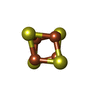
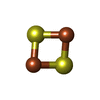
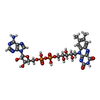
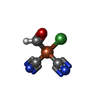



| #5: Chemical | ChemComp-SF4 / #6: Chemical | #7: Chemical | #8: Chemical | |
|---|
-Details
| Has ligand of interest | Y |
|---|---|
| Has protein modification | Y |
-Experimental details
-Experiment
| Experiment | Method: ELECTRON MICROSCOPY |
|---|---|
| EM experiment | Aggregation state: PARTICLE / 3D reconstruction method: single particle reconstruction |
- Sample preparation
Sample preparation
| Component | Name: Quaternary complex of the Pfu SHI complex / Type: COMPLEX / Entity ID: #1-#4 / Source: RECOMBINANT |
|---|---|
| Molecular weight | Experimental value: NO |
| Source (natural) | Organism:   Pyrococcus furiosus (archaea) Pyrococcus furiosus (archaea) |
| Source (recombinant) | Organism:   Pyrococcus furiosus (archaea) Pyrococcus furiosus (archaea) |
| Buffer solution | pH: 7.5 |
| Specimen | Conc.: 2 mg/ml / Embedding applied: NO / Shadowing applied: NO / Staining applied: NO / Vitrification applied: YES |
| Specimen support | Grid material: GOLD / Grid mesh size: 300 divisions/in. / Grid type: Quantifoil R2/1 |
| Vitrification | Instrument: FEI VITROBOT MARK II / Cryogen name: ETHANE / Humidity: 100 % / Chamber temperature: 283.15 K |
- Electron microscopy imaging
Electron microscopy imaging
| Experimental equipment |  Model: Titan Krios / Image courtesy: FEI Company |
|---|---|
| Microscopy | Model: TFS KRIOS |
| Electron gun | Electron source:  FIELD EMISSION GUN / Accelerating voltage: 300 kV / Illumination mode: FLOOD BEAM FIELD EMISSION GUN / Accelerating voltage: 300 kV / Illumination mode: FLOOD BEAM |
| Electron lens | Mode: BRIGHT FIELD / Calibrated magnification: 105000 X / Nominal defocus max: 1800 nm / Nominal defocus min: 1300 nm / Cs: 2.7 mm / C2 aperture diameter: 100 µm / Alignment procedure: COMA FREE |
| Specimen holder | Cryogen: NITROGEN / Specimen holder model: FEI TITAN KRIOS AUTOGRID HOLDER |
| Image recording | Average exposure time: 1.5 sec. / Electron dose: 60 e/Å2 / Film or detector model: GATAN K3 (6k x 4k) / Num. of real images: 17901 |
| EM imaging optics | Energyfilter name: GIF Bioquantum / Energyfilter slit width: 20 eV |
- Processing
Processing
| EM software |
| ||||||||||||||||||||||||||||||||||||||||
|---|---|---|---|---|---|---|---|---|---|---|---|---|---|---|---|---|---|---|---|---|---|---|---|---|---|---|---|---|---|---|---|---|---|---|---|---|---|---|---|---|---|
| CTF correction | Type: PHASE FLIPPING AND AMPLITUDE CORRECTION | ||||||||||||||||||||||||||||||||||||||||
| Particle selection | Num. of particles selected: 1640273 | ||||||||||||||||||||||||||||||||||||||||
| 3D reconstruction | Resolution: 3.47 Å / Resolution method: FSC 0.143 CUT-OFF / Num. of particles: 110211 / Symmetry type: POINT | ||||||||||||||||||||||||||||||||||||||||
| Atomic model building | Protocol: AB INITIO MODEL | ||||||||||||||||||||||||||||||||||||||||
| Atomic model building | Source name: AlphaFold / Type: in silico model | ||||||||||||||||||||||||||||||||||||||||
| Refinement | Highest resolution: 3.47 Å Stereochemistry target values: REAL-SPACE (WEIGHTED MAP SUM AT ATOM CENTERS) | ||||||||||||||||||||||||||||||||||||||||
| Refine LS restraints |
|
 Movie
Movie Controller
Controller






 PDBj
PDBj
